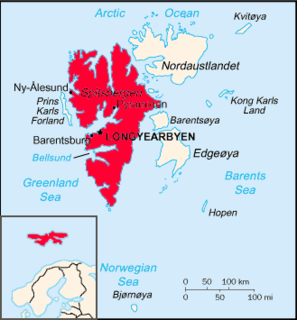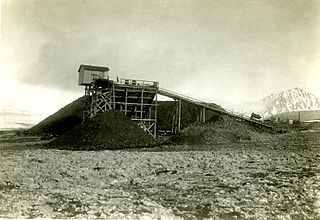
Svalbard, also known as Spitsbergen, or Spitzbergen, is a Norwegian archipelago in the Arctic Ocean. North of mainland Europe, it is about midway between the northern coast of Norway and the North Pole. The islands of the group range from 74° to 81° north latitude, and from 10° to 35° east longitude. The largest island is Spitsbergen, followed by Nordaustlandet and Edgeøya. The largest settlement is Longyearbyen.

Spitsbergen is the largest and only permanently populated island of the Svalbard archipelago in northern Norway.

Svalbard and Jan Mayen is a statistical designation defined by ISO 3166-1 for a collective grouping of two remote jurisdictions of Norway: Svalbard and Jan Mayen. While the two are combined for the purposes of the International Organization for Standardization (ISO) category, they are not administratively related. This has further resulted in the country code top-level domain .sj being issued for Svalbard and Jan Mayen, and ISO 3166-2:SJ. The United Nations Statistics Division also uses this code, but has named it Svalbard and Jan Mayen Islands.

Longyearbyen is the world's northernmost settlement and largest inhabited area of Svalbard, Norway. It stretches along the foot of the left bank of the Longyear Valley and on the shore of Adventfjorden, the short estuary leading into Isfjorden on the west coast of Spitsbergen, the island's broadest inlet. As of 2002 Longyearbyen Community Council became an official Norwegian municipality. It is the seat of the Governor of Svalbard. The town's mayor is Arild Olsen.
The Royal Ministry of Justice and Public Security is a Norwegian government ministry that oversees justice, the police, and domestic intelligence. The main purpose of the ministry is to provide for the maintenance and development of the basic rule of law. An overriding objective is to ensure the security of society and of individual citizens. The ministry was founded in 1818 and currently employs about 400 people in the central government department. Its subordinate agencies include the Norwegian Police Service, the Norwegian Correctional Service, the Norwegian Police Security Service, the Norwegian Prosecuting Authority, the Judiciary of Norway, and the Directorate of Immigration, and employ around 30,000 people. The Ministry of Justice of Norway oversees the administration of justice in Svalbard.

The Norwegian Polar Institute is Norway's central governmental institution for scientific research, mapping and environmental monitoring in the Arctic and the Antarctic. The NPI is a directorate under Norway's Ministry of Climate and Environment. The institute advises Norwegian authorities on matters concerning polar environmental management and is the official environmental management body for Norwegian activities in Antarctica.

Svalbard lies under the sovereignty of Norway, but the Svalbard Treaty places several restrictions. Norway cannot use the archipelago for warlike purposes, cannot discriminate economic activity based on nationality and is required to conserve the natural environment. Uniquely, Svalbard is an entirely visa-free zone. Everybody may live and work in Svalbard indefinitely regardless of country of citizenship. Svalbard Treaty grants treaty nationals equal right of abode as Norwegian nationals. Non-treaty nationals may live and work indefinitely visa-free as well. "Regulations concerning rejection and expulsion from Svalbard" is in force on non-discriminatory basis.

Svalbard Airport, Longyear is the main airport serving Svalbard in Norway. It is 5 km (3.1 mi) northwest of Longyearbyen on the west coast, and is the northernmost airport in the world with scheduled public flights. The first airport near Longyearbyen was constructed during World War II. In 1959, it was first used for occasional flights, but could only be used a few months a year. Construction of the new airport at Hotellneset started in 1973, and the airport was opened on 2 September 1975. It is owned and operated by state-owned Avinor.

Store Norske Spitsbergen Kulkompani (SNSK), or simply Store Norske, is a Norwegian coal mining company based on the Svalbard archipelago. It was formed in 1916, after a Norwegian purchase of the American Arctic Coal Company (ACC).
The Royal Norwegian Ministry of Trade and Industry was a Norwegian ministry responsible for business, trade and industry. On 1 January 2014 it was merged into Ministry of Trade, Industry and Fisheries. From 2013 it was led by Monica Mæland, who continued as minister of trade, industry and fisheries from 2014 to 2018.
The Government agencies of Norway are state controlled organizations that act independently to carry out the policies of the Government of Norway. The Government Ministries are relatively small and merely policy-making organizations, allowed to control agencies by policy decisions but not by direct orders. A Minister is explicitly prohibited from interfering with the day-to-day operation in an agency or the outcome in individual cases. While no minister is allowed to give orders to agencies personally, they are subject to decisions made by the Government. Also, the Minister is normally the instance of appeals of agencies decisions.

Arktikugol is a Russian coal mining unitary enterprise which operates on the island of Spitsbergen in Svalbard, Norway. Owned by the government of Russia, Arktikugol currently performs limited mining in Barentsburg. It has carried out mining operations in the towns of Pyramiden and Grumant, which it still owns, and once operated a port at Colesbukta. The company is headquartered in Moscow and is the official agency through which Russia, and previously the Soviet Union, exercised its Svalbard policy.

The Coal Authority is a non-departmental public body of the United Kingdom government sponsored by the Department for Business, Energy & Industrial Strategy. It owns the vast majority of unworked coal in Great Britain, as well as former coal mines, and undertakes a range of functions including:

The economy of Svalbard is dominated by coal mining, tourism and research. In 2007, there were 484 people working in the mining sector, 211 people working in the tourism sector and 111 people working in the education sector. The same year, mining gave a revenue of 2.008 billion kr, tourism NOK 317 million and research 142 million. In 2006, the average income for economically active people was NOK 494,700, or 23% higher than on the mainland. Almost all housing is owned by the various employers and institutions and rented to their employees; there are only a few privately owned houses, most of which are recreational cabins. Because of this, it is nearly impossible to live on Svalbard without working for an established institution. The Spitsbergen Treaty and Svalbard Act established Svalbard as an economic free zone and demilitarized zone in 1925.

Indre Wijdefjorden National Park is located in a steep fjord landscape in northern Spitsbergen in Svalbard, Norway. It covers the inner part of Wijdefjorden—the longest fjord on Svalbard. The national park was established on 9 September 2005 and covers 1,127 km2 (435 sq mi), of which 745 km2 (288 sq mi) is on land and 382 km2 (147 sq mi) is sea. The marine environment changes vastly from the mouth of the fjord, through a still, cold, water basin, becoming deeper before reaching the glacier Mittag-Lefflerbreen at the inner-most sections of the fjord.

Kongsfjord Telemetry Station was a satellite ground station located nearby Ny-Ålesund in Svalbard, Norway. It was used between 1967 and 1974 as one of the four initial ground stations which were part of the European Space Tracking Network (ESTRACK) serving the European Space Research Organization's (ESRO) first generation of satellites. The station provided radio tracking, telemetry and commanding services as well as data download. Although owned by ESRO, the facilities were constructed and operated by the Royal Norwegian Council for Scientific and Industrial Research (NTNF).

The history of Ny-Ålesund began in 1610, when coal deposits were discovered around Kongsfjorden. Not until the 1860s were they investigated more carefully. Ålesund-based Peter Brandal bought the claims in 1916 and established the company Kings Bay. The town, originally known as Brandal City and Kings Bay, was founded that summer when coal mining commenced. The first research installation, a geophysical station at Kvadehuken, was established in 1920. The mining was soon unprofitable and was kept running through state subsidies. In the mid-1920s the town was used for a series of airship expeditions towards the North Pole.

The Ny-Ålesund Town and Mine Museum is a museum located in Ny-Ålesund, a town on Spitsbergen, the central island of the Norwegian archipelago Svalbard in the Arctic Ocean. While some sources claim that the more well known Svalbard Museum holds the position, the museum is the world's northernmost such by virtue of Ny-Ålesund's position to the far north of the regional capital Longyearbyen.

The mining industry of Morocco is important to the national economy. Morocco is the world's largest producer of phosphate, and contains about 75% of the world's estimated reserves. Mining contributed up to 35% of exports and 5% of GDP in 2011. Foreign investors have found the investment climate, the infrastructure, fiscal situation, and political stability very favorable to continue business in the country in this sector.

The Ministry of Energy and Mineral Resources of the Republic of Indonesia is an Indonesian ministry responsible for providing assistance to the President and Vice President in performing government's affairs in the field of energy and mineral resources. The current minister is Arifin Tasrif.
















